
The Bachem Ba 349 Natter was a World War II German point-defence rocket-powered interceptor, which was to be used in a very similar way to a manned surface-to-air missile. After a vertical take-off, which eliminated the need for airfields, most of the flight to the Allied bombers was to be controlled by an autopilot. The primary role of the relatively untrained pilot was to aim the aircraft at its target bomber and fire its armament of rockets. The pilot and the fuselage containing the rocket motor would then land using separate parachutes, while the nose section was disposable.

In aircraft, an ejection seat or ejector seat is a system designed to rescue the pilot or other crew of an aircraft in an emergency. In most designs, the seat is propelled out of the aircraft by an explosive charge or rocket motor, carrying the pilot with it. The concept of an ejectable escape crew capsule has also been tried. Once clear of the aircraft, the ejection seat deploys a parachute. Ejection seats are common on certain types of military aircraft.
Martin-Baker Aircraft Co. Ltd. is a British manufacturer of ejection seats and safety-related equipment for aviation. The company's origins were originally as an aircraft manufacturer before becoming a pioneer in the field of ejection seats. The company's headquarters are in Higher Denham, Buckinghamshire, England with other sites in France, Italy and the United States.

The Boulton Paul Defiant is a British interceptor aircraft that served with the Royal Air Force (RAF) during World War II. The Defiant was designed and built by Boulton Paul Aircraft as a "turret fighter", without any fixed forward-firing guns, also found in the Blackburn Roc of the Royal Navy.

JSC Research & Development Production Enterprise Zvezda, or R&D PE Zvezda is a Russian manufacturer of life-support systems for high-altitude flight and human spaceflight. Its products include space suits, ejector seats, aircraft escape slides, lifejackets and fire extinguishers. It is based in Tomilino, near Moscow.

A drogue parachute is a parachute designed for deployment from a rapidly-moving object. It can be used for various purposes, such as to decrease speed, to provide control and stability, or as a pilot parachute to deploy a larger parachute. Vehicles that have used drogue parachutes include multi-stage parachutes, aircraft, and spacecraft recovery systems.

The Avioane Craiova IAR-93 Vultur (Vulture) is a twinjet, subsonic, close support, ground attack and tactical reconnaissance aircraft with secondary capability as low level interceptor. Built as single-seat main attack version or combat capable two-seat version for advanced flying and weapon training, it was developed as a joint Yugoslav-Romanian project in the 1970s for the air forces of both nations. The Romanian aircraft were built by I.R.Av. Craiova as IAR-93, and its Yugoslav counterpart by Soko as the Soko J-22 Orao. For Romania, the IAR-93 was intended to replace MiG-15s and MiG-17s in the fighter-bomber role.

An escape crew capsule is an escape capsule that allows one or more occupants of an aircraft or spacecraft to escape from the craft while it is subjected to extreme conditions, such as high speed or altitude. The occupant remains encapsulated and protected until such time as the external environment is suitable for direct exposure or the capsule reaches the ground.
Thunder City is an aircraft operating and maintenance company based at the Cape Town International Airport in Cape Town, South Africa. It was well known for owning the largest civilian collection of former military jet aircraft in the world. These aircraft were used to perform in airshows and could also be chartered by the general public for recreational flights, including going supersonic and climbing to altitudes around 50,000 feet. Following a fatal accident in 2009 in which an English Electric Lightning crashed at an airshow, the company ceased flying operations after the accident investigation found major shortcomings in its maintenance programme.
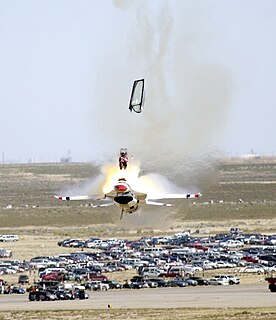
ACES II is an ejection seat system manufactured by the Collins Aerospace division of Raytheon Technologies (RTX). ACES is an acronym for Advanced Concept Ejection Seat. It is used in Fairchild Republic A-10 Thunderbolt II, McDonnell Douglas F-15 Eagle, General Dynamics F-16 Fighting Falcon, Lockheed Martin F-22 Raptor, Lockheed F-117 Nighthawk, Rockwell B-1 Lancer, WB-57, and Northrop Grumman B-2 Spirit aircraft. Over 10,000 ACES II seats have been produced with over 5,000 actively flying throughout the world as of 2013. It is known throughout the industry as the lowest life cycle cost third generation seat due to the USAF owning the rights to the seat, facilitating competitive replacement part procurement. In addition, the buying power of 5,000 in-service seats and previous service life extension programs have further driven down support costs.

The Martin-Baker Mk.7 is a British rocket-assisted ejection seat designed and built by Martin-Baker. Introduced in the mid-1960s, the Mk.7 has been installed in combat aircraft worldwide.

The Martin-Baker Mk.6 is a British rocket-assisted ejection seat designed and built by Martin-Baker. Introduced in the 1960s, the Mk.6 has been installed in combat and training aircraft worldwide.

The Martin-Baker Mk.5 is a British ejection seat designed and built by Martin-Baker. Introduced in the late 1950s, the Mk.5 has been installed in combat and training aircraft worldwide.

The Martin-Baker Mk.4 is a British ejection seat designed and built by Martin-Baker. Introduced in the 1950s, the Mk.4 has been installed in combat and training aircraft worldwide.

The Martin-Baker Mk.10 is a British rocket-assisted ejection seat designed and built by Martin-Baker. Introduced in the 1970s, the zero-zero capable Mk.10 has been installed in many combat aircraft types. A lightweight version is known as the Mk.10L.
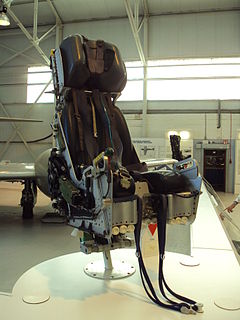
Martin-Baker Mk.8 is the designation given to two distinct British ejection seat types designed and built by Martin-Baker. The original use applies to a seat developed for the cancelled BAC TSR-2 strike aircraft project of the 1960s, re-use of the designation applies to a lightweight version of the Martin-Baker Mk.10 seat for the Short Tucano and other similar military training aircraft.

The Martin-Baker Mk.1 is a British ejection seat designed and built by Martin-Baker. Developed in the late 1940s it was the first in the line of production Martin-Baker seats for military aircraft. Ground and air testing of earlier designs resulted in the first successful test ejection of a company employee in July 1946. A seat type designed for the Saunders-Roe company was known as the Pre-Mk.1.
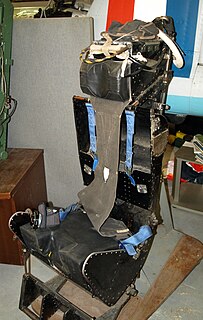
The Martin-Baker Mk.2 is a British ejection seat designed and built by Martin-Baker. Introduced in the early 1950s, the Mk.2 was developed from the Martin-Baker Mk.1, the main improvement being automatic parachute deployment.
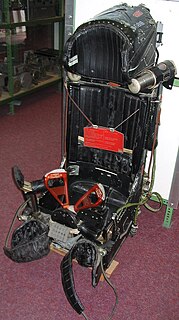
The Zvezda K-36 is a series of ejection seats made by NPP Zvezda. Variants of this ejection seat have been used on a variety of aircraft, including the Su-25, Su-27, MiG-29, Su-30 MKI and the Su-57.
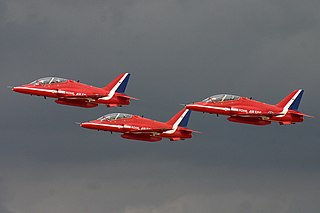
Flight Lieutenant Sean Cunningham was a Royal Air Force pilot on the Red Arrows aerobatics display team, who died when his ejection seat initiated whilst the aircraft he was in was stationary on the ground and he was conducting pre-flight checks. The incident occurred at the Red Arrows' home base, RAF Scampton in Lincolnshire, England. The initiation of the ejection seat was assumed to be by accident. The parachute on the seat did not deploy and Cunningham fell, still strapped to the seat, 220 feet (67 m) to his death 217 feet (66 m) away from the motionless aircraft. In January 2018, in the prosecution brought by the Health and Safety Executive, Martin-Baker, the manufacturers of the seat, pleaded guilty to a breach of health and safety law regarding Cunningham's death. On 23 February 2018, Martin-Baker were fined £1.1 million.


















